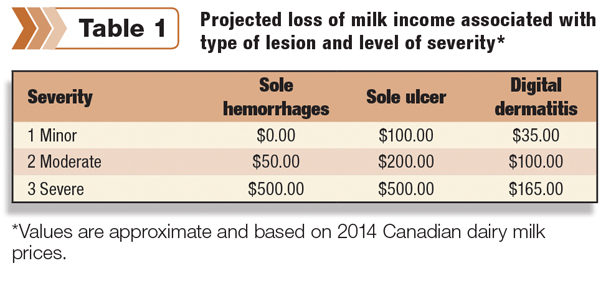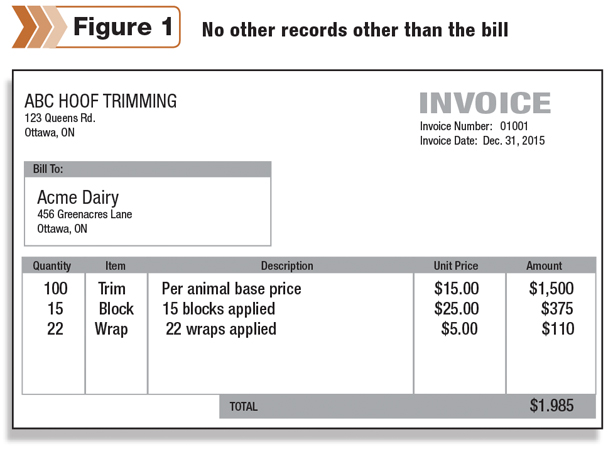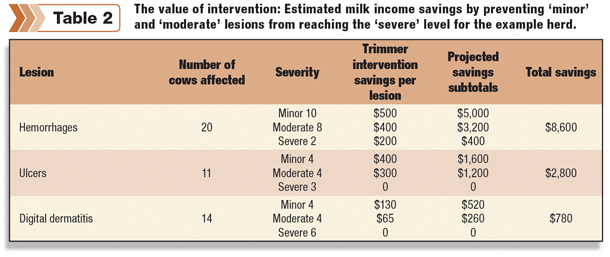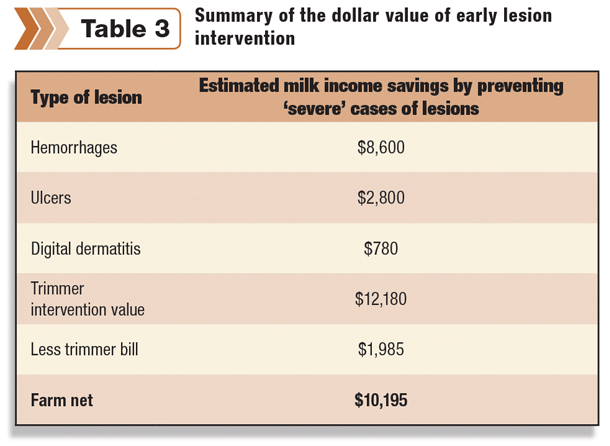This enables the analysis of current results and more importantly establishes a long-term pattern of the herd’s foot health. Identifying lesions as they occur allows better time and financial management for the farm.
That information can guide the farm towards optimal foot health by exposing problems that cause poor foot health. It can also expose positive elements to good foot health.
Here is an example of how recording creates a return on investment for the trimmer and the farm. Using a pro-rated financial value of three common and costly lesions and their varying levels of severity (Table 1), you can protect both the integrity of the trimmer’s work and the farm’s trust in developing strategies in which to invest.

Catching hoof lesions early through regular inspection is the role of recording and understanding lameness costs versus the return on investment in hoof care. The following scenario considers a group of 100 cows with a hoof trimmer’s base price of $15 per animal plus an additional $5 per wrap and $25 per block; it shows that 15 blocks and 22 wraps were applied among the group.
The following examples demonstrate the depth of information that hoof health records may provide, ranging from just the bill to more detailed information:
Example 1
No records other than the bill
What does this bill tell us? All we know from this information is that the trimmer fixed some sore cows in a 100-cow herd. It states that 100 cows were trimmed, with 15 blocks and 22 wraps applied.

Based on this information, you cannot establish animals that are affected via lactation profile (unless you are doing a specific group), chronic problem animals nor the incidence (current) or prevalence (whole herd over a set period of time) of lesions affecting your cattle.
Example 2
Basic animal records
You receive written documentation that states the following information: 11 cows with sole ulcers and one cow with a toe ulcer, 15 blocks applied; 14 cows with digital dermatitis (DD), 22 wraps applied; and 20 cows with sole hemorrhages.

With this information, you now know the actual animals and can create a history and establish lesion incidence. Now you have a benchmark of specific animals and lesions, and the farm trim bill is the same, $1,985.
Example 3
Detailed animal records
You receive a report identifying type of lesion, severity and treatment applied: 11 cows with sole ulcers and 15 blocks applied (four minor, four moderate and three severe); 14 cows with DD and 22 wraps applied (four minor, four moderate and six severe) and 20 cows with hemorrhages (10 minor, eight moderate, two severe).
Here, we have established each animal’s health history profile with a correct incidence and severity for establishing return on investment for trimming.

If a lesion is identified and treated early on, not only is the animal’s pain reduced and the lesion less likely to progress, but she is more likely to keep up her milk production, mobility and performance. Even a moderate hemorrhage in the solar horn area or an atypical site for a sole ulcer will cause an animal to limp.
With no intervention, it will develop into a sole ulcer, but with a trim, the trimmer can relieve that hemorrhage and prevent it from worsening. If there is a small amount of hemorrhage still left, it is an indicator that it was going to develop into an ulcer. If a hemorrhage is removed and no sign of one is left, then the lesion was self-resolving and has no monetary value.
The concept works the same with DD. If you can catch a minor blemish in the skin, you can prevent the disease from progressing. Therefore, the money is made by the farm from early detection, not treating problems. In order to understand the value of hoof records based on correct lesion identification, lesions should be considered an early warning system.
There is no dollar savings in a severe ulcer or DD rank. This is because the profit to the farm is gone; what you are dealing with is protecting what is left of the lactation that is reduced by the lesion. An ulcer can reduce a cow’s lactation by 10 percent if not treated within 10 to 14 days after diagnosing a cow as severely lame.
Examining this herd shows that if cows were being trimmed at a specific and regimented time line (every five months, as an example), the lameness rate would be just under 10 percent (nine out of 100 cows trimmed identified with severe lesions).
What needs adjusting? Perhaps the cows needing blocks could have been trimmed one month earlier by the farmer (if trained properly). The herd has DD but is again around the 10 percent mark. So all in all, this herd is not in bad shape, and the farm can now focus on the cows that are exposed as problems within the herd.
So what gives you the most value: a trimmer bill with no knowledge or a return on investment of $5 per every dollar invested in hoof care? Quality records prove profit to be expressed, giving the farm money to invest in measures to further improve hoof health. PD

-
Vic Daniel
- Hoof Trimmer
- Vic’s Custom Clips
- Email Vic Daniel








